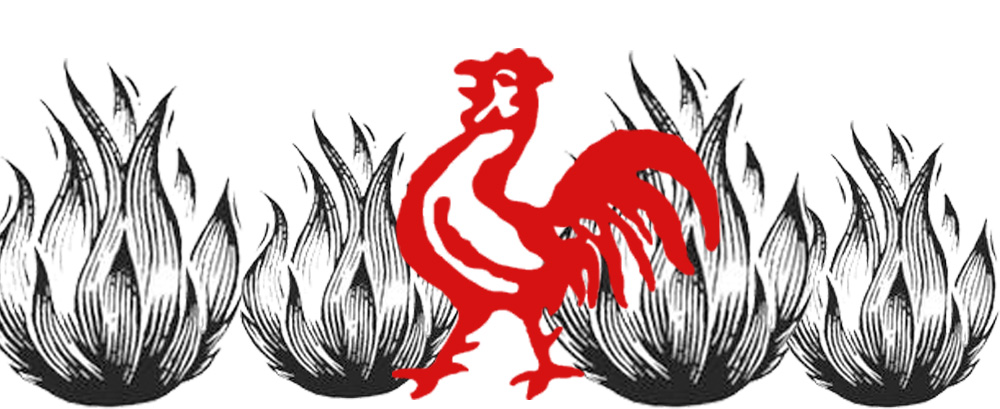Monday, January 23rd
January 22, 2017Tuesday, January 24th
January 23, 2017This week, on January 28th, billions are due to celebrate the beginning of the Year of the Rooster. It thus behooves us to take a break from strictly planetary prognostication and consider the symbolic power of the rooster.
Humans have had a long time to observe the rooster’s behavior and ponder its significance. It is currently estimated that chickens were domesticated over 6-8000 years ago in Southeast Asia. These resilient fowl successfully spread throughout the globe, occasionally interbreeding with other species until they reached their current status, with a population of just under 20 billion and a presence on every inhabited continent. There are few animals which human beings have had a longer or more consistent relationship with. World mythology and folklore thus overflows with ideas and opinions about the rooster.
Because it crows every morning to announce the dawn, the rooster has long been seen as a herald. This garishly arrayed bird is also territorial and combative, and has thus been widely associated with both the virtues and vices of warriors. It has also been used as an image of masculine vanity due to its colorful appearance and manner. Finally, because of its rapid rate of reproduction, it is also a symbol of virility and fecundity.
It is interesting to note how the relative sexual dimorphism of the chicken plays into the rooster’s symbolism, as few other animals have sets of meanings as divergent as those of the male and female chicken. In contemporary English, for example, to be a “chicken” is to be a coward, whereas to call someone a “rooster” carries none of the same charge. We might call someone a “cock,” or say that they are “cock of the walk,” but this indicates that a person’s presence is too aggressive, too intrusive, and that they think too highly of themselves. It in no way indicates that the person is fearful and prone to flee at the first hint of conflict.
Yet the behaviors of the rooster and the hen are interdependent. Their roles make sense only in relationship to one another. Thus, although the hen rarely gets the attention that the bold rooster receives, it is worth a moment to consider the intersection and interdependence of the two. For even when it is only the rooster we hear crowing or see fighting, it does so only because of the hidden hen.
Charbroiled Chicken
Though it is undoubtedly the year of the Rooster which we approach, there is an additional layer of symbolism which filters the meaning of rooster. This additional layer is that of the “elements,” the system of the Wu Xing, or 5 phases. The 5 five phases are nearly ubiquitous in traditional Chinese culture, and play a significant role in traditional Chinese medicine, feng shui, music, astrology and martial arts.
This coming Chinese New Year is not merely the year of the Rooster, but the year of the Fire Rooster. Fire is expansive, hungry, aggressive and dynamic. Fire provides an important contrast with the “natural” phase to which the zodiacal Rooster corresponds, metal. Metal is cool, precise, self-sufficient and able to maintain form, or pose, indefinitely. It is very different from dynamic, hot, hungry fire.
The contrast between fire and metal in the wu xing is considered systematically, through a sort of 5-fold version of Rock-Scissors-Paper. Each “element” in the wu-xing is considered to be controlled or destroyed by another element. Metal looks to Fire as its destroyer, a relationship often abbreviated as “fire melts metal.”
When “fire melts metal,” what is cool, calm and poised is overcome with excitation. When we look at the emotional qualities associated with metal, we see such terms translated as uprightness, dignity, reserve and precision. With fire melting metal, we see powerful states such as joy and hate overcoming the cool, dignified states referred to by metal.
This is the second year in a row where the natural element of the animal and the element of the year are in a disharmonious relationship. Last year, the Year of the Monkey, was also a “fire melts metal” year, with the theme of passion and excitation overcoming reserve and dignity very much in play. Therefore, as we consider the rooster, we should look toward the louder and more dramatic aspects of its behavior.
The Herald of Morn
The rooster crows at dawn, announcing the Sun’s daily rise. The rooster is thus a time-keeper and watcher. It is more specifically a solar herald, as the rooster does not signal midnight, but dawn. It announces the coming of the light- not its culmination or disappearance.
The relationship between the rooster and the Sun is thus of great and obvious importance, and has therefore been widely encoded in world-myth. The Rooster is, for example, often pictured with the ancient Greek sun-god Apollo.
The Sun, as the celestial origin-point of light and life, is often used as a proxy for the idea of spirit— the subtle, intelligent, animating and vitalizing substance which infuses all living beings. Thus the rooster acts, in many stories, as the herald not only of the Sun, but of the spirit. The rooster here is the visible, audible announcer of the silent, unseen action of spirit.
This role as “herald of the invisible” can be seen in the many traditions which associate the rooster with protection from evil spirits. The rooster is seen as an alarm system, warning of the approach of foul forces. Furthermore, the rooster’s cry is also features in many rites whose purpose is expel such unwanted company. It is no stretch to see the logic here, as the rooster daily announced the triumph over light over darkness, a primordial exorcism of the spirit of night.
The rooster is thus associated with vigilance in many traditions. It watches and warns. It raises the alarm and calls to arms. This role as watcher and guardian demands the sort of patience, poise and precision associated with the earlier-discussed element of metal. Outside of emergencies, the guardian is silent.
This is the ideal, but not necessarily the reality. With our poor year of the rooster subject to the elemental quality of fire, we are likely to have an abundance of loud, raucous warnings which may or may not signify legitimate alarms. This phenomenon is familiar to anyone who has kept chickens, and found themselves with a bird that has decided to crow at approximately 2 AM every night, instead of at dawn. This brings us to the story of “Chicken Little,” a barnyard tale of false alarm of which at least 200 variations have been recorded. The bare bones of the story go something like this:
One day, an acorn falls on Chicken Little’s head. From this very particular and individual experience, he extrapolates that the sky itself must be falling. Once he has fixed this interpretation, he takes upon himself the great duty of warning the rest of the barnyard. He becomes, like the angel Gabriel in Revelations, the herald of the impending apocalypse. Through a series of conversations, he convinces the other barnyard animals that the sky is indeed falling, and that they should find a way to shelter themselves from this coming Ragnarok. At some point, Fox wanders onto the farm and hears Chicken Little preaching the gospel of the end-times. Fox then tells the terrified animals not to fear— he will shelter them all in his burrow, where they will be safe from the sky-born catastrophe. Chicken Little and the other animals all file into the burrow, and once inside and safe from the falling sky, are promptly devoured by clever Fox.
The primary lesson here is that people in a state of alarm can be more easily manipulated into a course of action that looks safe, but may be anything but. The guardian who raises a false alarm can doom the very ones they hope to protect.
This story has an interesting relationship with another common pastoral tale of flawed vigilance- “The Boy Who Cried Wolf.” In this story, a boy is tasked with watching his family’s sheep, and to raise the alarm when the wolf shows up. The boy cries “wolf!” multiple times, but every time, when his father comes running, there is no wolf to be found. One day, the wolf really does show up, and when the boy raises the alarm, no one believes him. The flock is devastated, and his family’s livelihood endangered.
These stories of watchers, their mistakes and their temptations, are especially relevant right now. Our digital lives are subject to a near-constant inundation of terrifying warnings. Every food gives you cancer. Every tragedy is the result of sinister conspiracy. Everyone is a terrorist, a fascist, a socialist, a racist, a sexist. The internet is a crowded theatre, its air vibrating with near-constant cries of “Fire!”
As tempting as it would be to dismiss the whole cacophony out of hand, a bare examination of the facts shows that this is indeed a volatile time, with very real dangers. We are thus put in the difficult position of having to sort the signal from the great wall of noise. Furthermore, insofar as we are not merely witnesses to the digital world, but its creators and broadcasters, we have the responsibility to be discerning about what we trumpet to our circle.
Magnificently Loud
The rooster is not only loud in its warnings and exclamations, it is also loud visually. The rooster’s dramatic appearance serves both to intimidate rivals and predators, as well as to attract mates. The bird’s bravery, which is usually considered in martial terms, is also the courage to perform. It is the confidence to be seen and heard, and the power of that appearance. The image we radiate colors the way the world sees us, and therefore reacts to us. It is a superficiality with deep power.
Thus one potentially positive quality of this particularly loud rooster year is its capacity to entertain. Though spectacle and theatricality may be unpleasant on a personal level, they are virtues within the context of many art forms. Thus, for those who could use a shot of confidence, this is a good rooster to ride toward aesthetic goals.
Yet the performative rooster clearly has its drawbacks. To be seen and heard is everyone’s right, but some people are wont to claim an unduly large portion of attention. The vain and attention-hungry may thus be tempted to be abuse the rooster’s courage, turning virtue to vice.
The Resplendent Combatant
In addition to its role as herald and time-keeper, the rooster is also widely admired for its bravery and martial prowess. Though its linkage to the Sun is obvious, the Rooster is also strongly connected to the combative sphere of Mars. In some cases this is implied, while in others it is overt. The Indian deity Karitikeya, often identified with Mars, carries a banner with a rooster emblazoned on it. The Mespotamian Nergal, also strongly associated with Mars, was also represented with rooster imagery.
The reason for these martial associations is the rooster’s highly territorial, combative behavior. A rooster will not suffer a rival in its small kingdom, and will attack any male which intrudes. Roosters are well equipped for combat, as they possess exceedingly tough, sharp claws which tear easily through feather and flesh alike.
So armed, the rooster is one of the animals that punches well above its weight class, attacking much larger animals which threaten its territory. As it is not easily cowed, even in the face of daunting opposition, the rooster denotes bravery in a great number of cultures.
The rooster is also strongly associated with physical strength and vitality. The extremely challenging rooster pose in Hatha Yoga is said to cultivate physical vigor and sexual potency, and a number of martial traditions look to the rooster for inspiration. Agility, precision and aggression characterize the Rooster sub-styles of Hsing-Yi and Ba Gua Zhang.
Constant Creation
Yet the rooster’s vital power is not solely aggressive and destructive. It is also fecund and procreative. Chickens reproduce at an astonishing rate, and are thus common symbols of both fertility and good fortune. The rooster is one half of a duad of constant reproduction. Indeed, in the ancient Egyptian Annals of Thutmose III, the chicken is referred to as “the bird which gives birth every day.”
Virility and territoriality are the male’s part in this impressive process of biological creation. The hen has her own form of vigilance— the constant incubation of eggs and watchfulness over the young. Without both rooster and hen, there would be no chickens, and no eggs. It thus behooves us to consider the hen as an exemplar of complementary virtues.
Eggs are biological beginnings, whose meaning is expanded outward in a score of cultures to encompass all beginnings, even that of universe itself. All new things, once their pattern is dreamed, must be incubated until they are strong enough to survive on their own. This the hen’s knowledge, for it watches this cycle over and over again. While the rooster’s vigilance is extended toward the perimeter, the hen’s attention is anchored to the center.
Yet not all eggs, not all ideas, prove viable. Chickens do not invest the future of their species into the rare egg, but instead a great ovoid multitude. The hen teaches us to be constantly and naturally creative. Create and incubate as a matter of regular being, not as a spectacular, single event.
Melting Metal, Nourishing Earth
As stated in the introduction, this is not merely the year of the Rooster, but the year of the Fire Rooster. As fire melts metal, so the excitations and dramas of this year threaten the vigilance, precision and punctuality which the rooster thrives on.
Yet while fire may melt metal, it is also said to feed, or nourish, earth. The loud always gives way to the silent, the volatile to the stable. This elemental sequence is represented not only in the wu-xing, but also in the order of the elements in the “Western” zodiac, with earth signs always following fire signs.
Just as P.T. Barnum, the famous purveyor of circus spectacle, turned tawdry theatrics into cold hard cash, the raging dramas of 2017 will serve plenty of interests. Media companies whose numbers depend upon outrage and catastrophe will certainly profit from the rooster’s squawks.
Similar strategies are seen in the animal kingdom. Many creatures wait for fire to become earth. We might look to the patience of scavengers, who wait out the war between lions and wildebeasts, then sneak in to feast without the exertion or danger of the hunt. This was also the strategy of the fox in the story of Chicken Little, who waited patiently to fill his larder. Enduring fire is also the manner in which many forests maintain health and promote new growth. Fire culls the unstable, leaving behind the strong.
Thus, hiding amidst the loud, colorful terrain of the Year of the Rooster are quiet opportunities. Nurture small advantages— lay eggs daily. You may or may not be called to make tremendous efforts, or to participate in great stories, but in the meantime, do not spurn the chance to make humble advances.
And so, during this Year of the Rooster, take care which heralds you heed, and what cries you add the sound of your voice to. Find your courage to fight, but remember your responsibility to the eggs, the potentials, you’re trying to incubate. Get ready to pry open your heart, as it will require the compassion of a Bodhisattva to deal with the raucous squawking of the other 7 billion people you’ll share the Year of the Rooster with.






5 Comments
Thank you Austin-once again. I enjoyed the images you created here. They certainly seems apropos..
Brilliant commentary Austin…thank you! Your points should make it easier to wade through the multitudes of crowing and clammering. As I was born in a year of Wood Rooster…that is neither fire nor metal, but a combustible material. Hmmm.
Many thanks, Feathery Inferno is now my new drag queen name. On a serious note, love your analyses and interpretations… They help me get through the week!
Thanks, great take on the year to come!
COCK-A-DOODLE-DO!!!!!!! Just don’t wake me before 10 AM!!!!!
Austin, what is this enormous star or planet blinding my eyes around 5:30 – 6:00 PM over NYC??? I have never
seen a star or planet that HUGE and BRIGHT in the sky before!!! Haunting! Is it Saturn???
Yours ascending, Spike ( spike neuberger on YouTube )